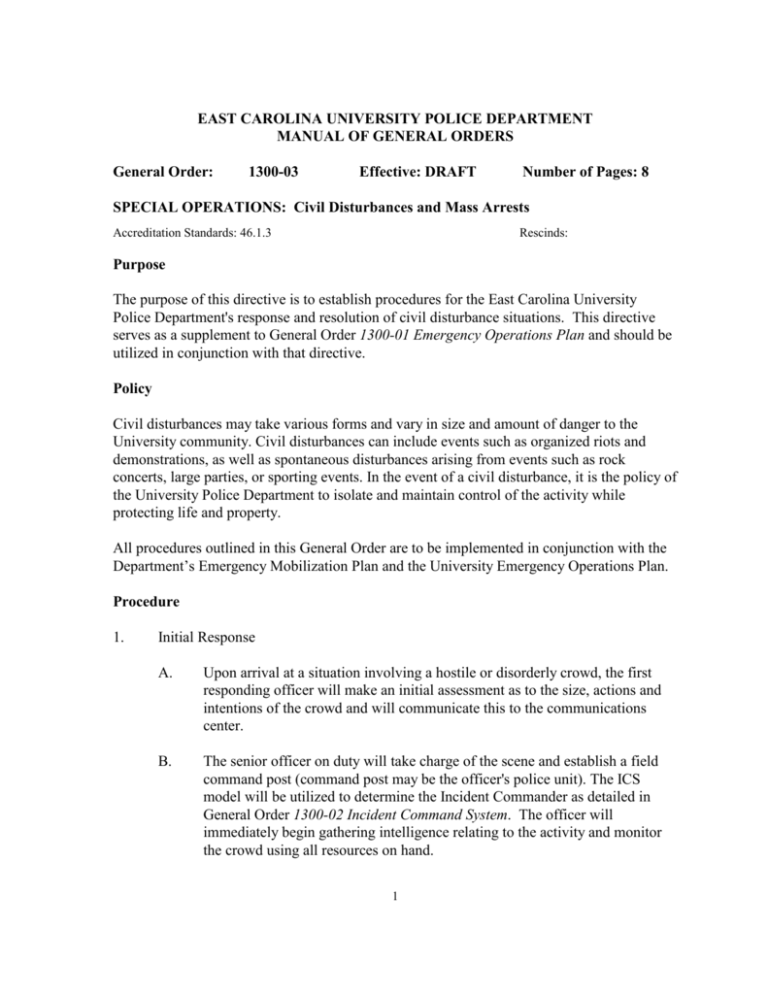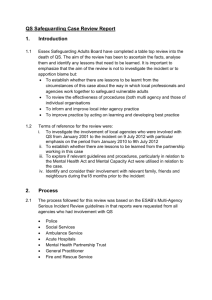EAST CAROLINA UNIVERSITY POLICE DEPARTMENT
advertisement

EAST CAROLINA UNIVERSITY POLICE DEPARTMENT MANUAL OF GENERAL ORDERS General Order: 1300-03 Effective: DRAFT Number of Pages: 8 SPECIAL OPERATIONS: Civil Disturbances and Mass Arrests Accreditation Standards: 46.1.3 Rescinds: Purpose The purpose of this directive is to establish procedures for the East Carolina University Police Department's response and resolution of civil disturbance situations. This directive serves as a supplement to General Order 1300-01 Emergency Operations Plan and should be utilized in conjunction with that directive. Policy Civil disturbances may take various forms and vary in size and amount of danger to the University community. Civil disturbances can include events such as organized riots and demonstrations, as well as spontaneous disturbances arising from events such as rock concerts, large parties, or sporting events. In the event of a civil disturbance, it is the policy of the University Police Department to isolate and maintain control of the activity while protecting life and property. All procedures outlined in this General Order are to be implemented in conjunction with the Department’s Emergency Mobilization Plan and the University Emergency Operations Plan. Procedure 1. Initial Response A. Upon arrival at a situation involving a hostile or disorderly crowd, the first responding officer will make an initial assessment as to the size, actions and intentions of the crowd and will communicate this to the communications center. B. The senior officer on duty will take charge of the scene and establish a field command post (command post may be the officer's police unit). The ICS model will be utilized to determine the Incident Commander as detailed in General Order 1300-02 Incident Command System. The officer will immediately begin gathering intelligence relating to the activity and monitor the crowd using all resources on hand. 1 C. 2. 3. At this point, no further action should be initiated by the police except to prevent injury to bystanders or major property damage. Communications Responsibilities A. Upon receipt of the initial assessment from the Incident Commander, the onduty telecommunicator will notify the Operations Commander or, if after normal business hours, the Staff Duty Officer and advise them of the officer's assessment. B. The telecommunicator will monitor the situation and disseminate additional information as it is received. If the incident escalates to the point of a Level-1 or Level-2 Emergency as described in General Order 1300-01 Emergency Operations Plan, the Operations Commander or Staff Duty Officer will ensure that the Chief of Police is notified. C. Communications will serve as the contact point for other agencies unless otherwise stated by the Incident Commander. Determination of Manpower Needs A. The Chief of Police, or designee, will make a determination as to resolving the situation with on-duty resources, or to declare a Level-1 or Level-2 Alert requiring additional resources. At that time the department Emergency Operations Plan shall be put into effect. B. Once the determination is made for more personnel, Communications will begin callback of all full-time and reserve personnel. Personnel should be instructed to report to the Police Department headquarters building or to the designated staging area as determined by the Incident Commander. C. If a determination is made to request assistance from other agencies, the Chief of Police, or designee, will have Communications contact the Greenville Police Department, Pitt County Sheriff Department, the N.C. Highway Patrol, or any other agency in which an interagency agreement exists for the following purposes: (1) Advise of all known circumstances of the situation. (2) Request additional police assistance as advised by the Chief or designee. (3) Request that the on-duty shift supervisor or other higher ranking command official of the assisting agency be notified of the 2 circumstances of the request. (4) D. The Chief of Police, or designee, and the ranking police official of the assisting agency will jointly plan and implement any immediate course of action deemed appropriate to resolve the situation. The Chief of Police or designee will remain the Incident Commander. E. Members of the Police Department and those from assisting agencies will assume a support role in the operation. This role may include, but is not limited to: F. 4. Advise of the location of the assembly area/command post. (1) Traffic and bystander control; (2) Supplying geographical and building data; (3) Assisting in the mass arrest procedure; (4) Providing transportation; (5) Assisting in establishing a field command post and staging area; and (6) Any other activities requested by the Incident Commander. The Chief of Police or designee will serve as the liaison between all police personnel and University Administrators. The Chief will actively participate in any decision concerning the use of force, the use of chemical agents, or the initiation of mass arrests. Civil Disturbance Interdiction and Crowd Control Once appropriate and adequate personnel and equipment are in place, the Chief of Police or designee will ensure that the following steps are implemented: A. Approach the crowd and inform the leaders that the assembly is unlawful, and the crowd will have to disperse. If the crowd is violent, this may be accomplished by use of a P.A. system. B. A time limit for dispersal should be established and no extensions permitted. C. If the crowd fails to disperse and continues its activity, the Chief of Police or designee will: 3 D. 5. 6. (1) Authorize the use of force or chemical weapons, as appropriate; and/or (2) Order the formation of police lines and establish crowd control. If time and resources permit, an officer will be assigned to record operations related to crowd control by use of video equipment. Legal and Prosecutorial Liaison A. The Chief of Police or designee will notify the District Attorney or appropriate representative of the North Carolina Attorney General’s Office whenever an unusual occurrence develops on campus that may involve unusual legal considerations such as in barricade/hostage situations or where multiple arrests are anticipated. In major incidents, this liaison may be accomplished through the assisting law enforcement agency. B. Chapter 14-288 of the North Carolina General Statutes provides for the legal disposition of persons participating in riots and civil disorders. It also empowers the Governor of the State to promulgate emergency rules and regulations, commit State militia and other law enforcement agencies. Public Facility Security Personnel not assigned to specific duties related to the incident will be responsible for securing University facilities adjacent to the incident area to ensure the continuance of essential university services. In some instances, it may be necessary to evacuate and secure areas or buildings to safely guard persons and property. 7. Intelligence/Threat Assessment The Chief, or designee, will designate an investigator to serve as the intelligence/threat assessment officer when the situation dictates. This officer is responsible for establishing on-site surveillance in order to assess objectives of the crowd, monitor crowd size and movement, and predict crowd action, as well as reporting any other pertinent intelligence information the surveillance produces. In large-scale occurrences, this activity may be conducted by, or in conjunction with, the appropriate assisting agency. 8. Mass Arrests A. During the course of a civil disturbance, arrests may become a reality. These arrests must be handled quickly and efficiently, providing for transportation, release, arrestee rights, etc. The following procedures will apply as necessary: 4 (1) The designated Incident Commander will ensure that an arrest team is established to handle prisoners and will provide personnel as needed to staff the arrest team. A police supervisor, if available, will oversee the operation of the arrest team. (2) The supervisor will ensure proper assignments are made to provide security for the field command post and the field booking area. (3) Arrested persons will be removed from the point of disturbance by the arresting officer and brought to a point where the initial booking will take place. (4) Arrest team duties will include: a. Establishing detention areas for arrested persons during the field booking. b. Photographing the arrested person with the arresting officer with a digital or Polaroid camera. The officer(s) taking photographs will maintain a log of all photos taken. Arrest/identification information will be recorded on the back of the photo when using the Polaroid camera. Established State laws and Department policies regarding taking photos of juveniles will be adhered to at all times. c. Preparing field arrest forms. d. Providing for the proper collection, tagging, identification and preservation of personal property and evidence collected at the time of any arrest. (5) The supervisor will ensure officers are assigned to provide transportation of the prisoner to the Pitt County Detention Center where formal charging/booking will take place. The Pitt County Sheriff Department will be requested to provide prisoner buses for mass transport. If the number of arrests requires additional transport capacity, the Department of Corrections may be contacted by the Chief or Incident Commander and a larger D.O.C. bus utilized for transport. (6) Arrested persons will be allowed the opportunity to contact legal counsel at the conclusion of the booking process. (7) Arrested persons who are injured will be given medical treatment before being transported to the Pitt County Detention Center. 5 B. 9. Any necessary provisions of food, water and sanitation for prisoners will be coordinated through the Pitt County Detention Center or the commander of the assisting agency. (9) The District Attorney, or designee, will provide legal advice to the Incident Commander as appropriate. Magistrate's assistance will be coordinated by the Incident Commander in conjunction with the field arrest team. (10) Juveniles involved will be segregated from adult offenders and processed in accordance with normal department policies and procedures relating to juvenile operations. Only the minimum force to effect an arrest or control will be authorized. All use of chemical agents for the purpose of crowd control or arrest must be authorized by the Chief of Police or designee. Media Operations A. The University public information representative will respond to appropriate news media requests. If unavailable, the ECU Police Department Public Information Officer will assume all media relations duties. B. News media briefings will be held on an “as needed” basis, intended to: C. 10. (8) (1) Inform the public of imminent or present danger; (2) Provide casualty information; (3) Provide property damage reports; (4) Provide warnings to potential looters and others involved in criminal acts; (5) Provide a means to control rumors. All news media releases will be in accordance with University and Departmental procedures. De-Escalation Procedures Once the disturbance has been brought under control, the Chief of Police, or designee, will begin de-escalation procedures, to include: 6 11. A. Ensure that all available evidence is collected. B. Disengage officers, as appropriate. C. Ensure that all Department equipment is accounted for and collected. D. Terminate Incident Command and notify Communications of termination. E. Continue extra patrol in the area for the balance of the patrol shift. Post Occurrence Duties A. B. All key personnel participating in the control of a civil disturbance/mass arrest situation will prepare an after action report that will detail: (1) the incident itself; (2) all actions taken by the officer; (3) final outcome of incident; (4) any injuries occurring to persons or property; (5) use of force reports, if applicable. The Incident Commander or his/her designee will prepare and submit the final after action report which includes the after action reports of the other key persons involved. Details of the report should include: (1) A chronological log of all significant events; (2) Copies of related offense reports, supplemental reports and narratives from individual officers; (3) Any other pertinent information received from other agencies or individuals including photographs, news articles, videos, etc; (4) In Level-2 incidents involving outside agencies, the Incident Commander’s after action report will be submitted for inclusion into the appropriate agency's final report on the incident. 7 APPROVED: DRAFT Robert C. Stroud Chief of Police 8








